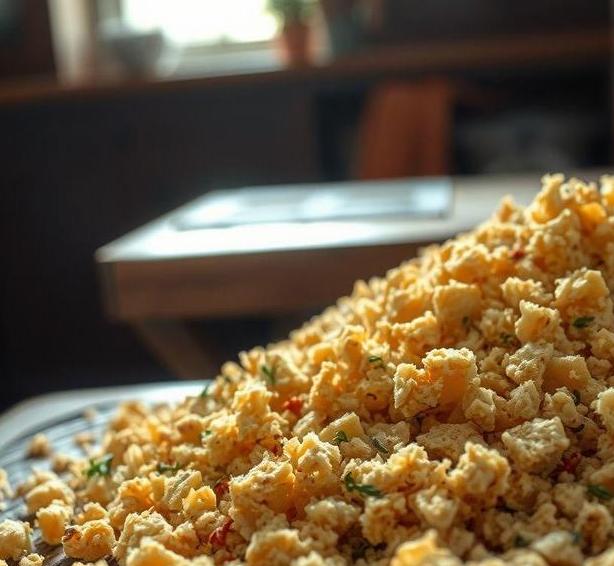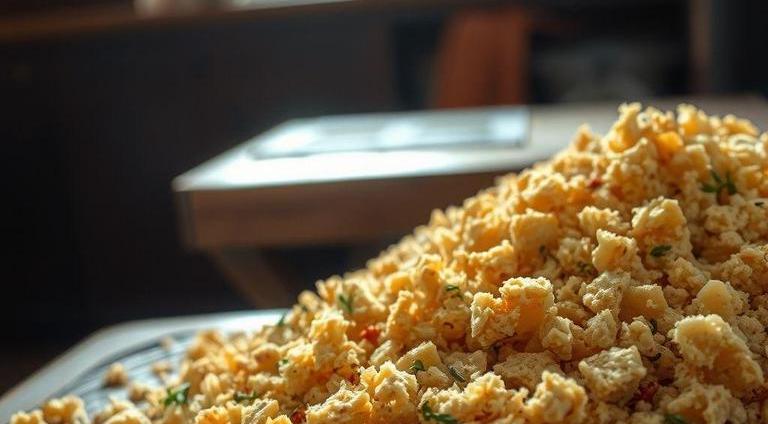Can Breadcrumbs Go Bad : What You MUST Know
Breadcrumbs are a kitchen staple that adds texture, flavor, and versatility to countless dishes. From coating chicken and fish to adding a crunchy topping for casseroles or meatballs, breadcrumbs make cooking easier and more flavorful. But, like any ingredient, they have a shelf life. Have you ever wondered whether breadcrumbs can go bad? Or perhaps you’ve found a half-used bag of breadcrumbs stashed in the back of your pantry and thought, “How long can I keep these”?
The good news is, breadcrumbs have a decent shelf life, but they’re not immune to spoilage. Understanding how long they last, what signs to look for, and the best storage methods will help you make the most of this pantry item. Let’s dive into all the details, so you can avoid wasting breadcrumbs and ensure your dishes are always up to par!
Can Breadcrumbs Go Bad?
The short answer: Yes, breadcrumbs can go bad. They’re made from bread, which is inherently a perishable item. Once bread is dried into breadcrumbs, it still contains a bit of moisture, especially if it’s homemade. This moisture can lead to spoilage over time, causing them to lose flavor or even grow mold. However, commercially prepared breadcrumbs generally have preservatives to extend their shelf life, so they might last longer than homemade versions.
The key to keeping breadcrumbs fresh for as long as possible lies in proper storage and knowing when it’s time to toss them.
Shelf Life For Breadcrumbs

The shelf life of breadcrumbs largely depends on whether they are homemade or store-bought and how they are stored. Here’s a breakdown:
-
Store-bought breadcrumbs: These typically contain preservatives, so they can last much longer.
- Unopened package: About 6 to 9 months past the best-by date if stored properly in a cool, dry place.
- Opened package: Around 3 to 6 months. Once the package is opened, exposure to air and humidity can affect their freshness.
-
Homemade breadcrumbs: Since they lack preservatives, homemade breadcrumbs have a shorter shelf life.
- In the pantry: About 1 to 2 weeks if kept in an airtight container.
- In the fridge: Can last up to 2 to 3 weeks.
- In the freezer: Can last up to 6 months or even longer, though freezing will affect the texture.
Common Signs Of Spoilage
Breadcrumbs may not always show obvious signs of spoilage, but there are some telltale signs to watch out for. Here’s what you should check:
- Off smell: Fresh breadcrumbs have a pleasant, mild aroma. If they start to smell rancid or sour, they’re likely past their prime. The rancid smell could indicate that the fats in the breadcrumbs (from butter or oil) have gone bad.
- Mold: If you see any mold growing on your breadcrumbs, it’s a clear sign they’ve spoiled. Mold often appears as green, black, or white fuzzy spots. In this case, it’s best to discard them entirely.
- Changes in texture: If your breadcrumbs feel damp, soggy, or unusually soft, they may have absorbed moisture and are starting to spoil. A change in texture, especially when the breadcrumbs are supposed to be dry and crisp, is a major warning sign.
- Color changes: While breadcrumbs are usually a light golden-brown or beige color, if they start turning dark brown or black, they may have become stale or burnt. This could be due to improper storage or exposure to air.
- Taste: If you’re still uncertain whether your breadcrumbs are good, you can always taste a small sample. Stale or spoiled breadcrumbs will have an off taste, often bitter or rancid.
How To Store Breadcrumbs?

Proper storage can extend the life of your breadcrumbs, so it’s essential to follow these guidelines to keep them fresh for as long as possible:
In A Cool, Dry Place (Pantry)
- For unopened, store-bought breadcrumbs, a cool, dry pantry is ideal. Ensure the package is tightly sealed to avoid exposure to moisture.
- Homemade breadcrumbs should be stored in an airtight container to keep them from absorbing humidity and odors from other foods.
Refrigeration
- If you live in a particularly humid or warm climate, or if you’ve made homemade breadcrumbs, refrigerating them can help prolong their freshness.
- Always keep breadcrumbs in a sealed, airtight container to avoid moisture buildup.
Freezing For Long-Term Storage
- Freezing is an excellent option if you’ve made a big batch of breadcrumbs or if you want to extend the shelf life of store-bought ones.
- Use a freezer-safe bag or container and squeeze out any excess air. Label it with the date so you know when you made or purchased them.
- When ready to use, allow the breadcrumbs to thaw at room temperature or toss them straight into your dish if you’re cooking them.
Avoid Exposure To Air
- Oxygen can break down the quality of breadcrumbs over time, causing them to lose their freshness. Always make sure the container is sealed tightly after each use.
Expert Tips
- Use airtight containers: Whether you’re storing store-bought or homemade breadcrumbs, using a vacuum-sealed or tightly-lidded container is one of the best ways to preserve their quality.
- Refresh stale breadcrumbs: If your breadcrumbs have lost some of their crispness but are still safe to use, try refreshing them by toasting them lightly in the oven or on the stovetop. This can bring back the crunch and make them perfect for coating or topping dishes.
- Flavoring homemade breadcrumbs: If you’re making breadcrumbs yourself, consider adding herbs and spices to enhance the flavor right from the start. This can help boost their flavor profile and make them more versatile in a variety of dishes.
- Don’t store near strong-smelling foods: Like all dry ingredients, breadcrumbs can absorb odors from nearby foods. To prevent this, store them away from spices or strongly scented items such as onions or garlic.
FAQs
Can Breadcrumbs Go Bad Over Time?
Yes, breadcrumbs can go bad over time. While they may last for a long time when stored properly, they can eventually become stale, lose their flavor, or develop mold if exposed to moisture.
How Long Do Breadcrumbs Last?
The shelf life of breadcrumbs depends on their storage conditions. Unopened breadcrumbs can last up to 6-12 months if stored in a cool, dry place. Once opened, they are best used within 3-6 months for optimal freshness.
How Can I Tell If Breadcrumbs Have Gone Bad?
Breadcrumbs that have gone bad may have an off or rancid smell, a change in color (such as darkening or mold), or a soft, soggy texture. If they appear moldy or have an unpleasant odor, it’s best to discard them.
What Is The Best Way To Store Breadcrumbs To Prevent Them From Going Bad?
To prevent breadcrumbs from going bad, store them in an airtight container in a cool, dry place away from sunlight and humidity. You can also refrigerate or freeze them for extended shelf life.
Can Breadcrumbs Become Stale?
Yes, breadcrumbs can become stale if exposed to air. Stale breadcrumbs may lose their crisp texture and flavor, but they are generally still safe to eat if there is no mold or off smell.
Can I Use Breadcrumbs Past Their Expiration Date?
Using breadcrumbs past their expiration date is not recommended, especially if they show signs of spoilage, like mold or a rancid smell. If they are still in good condition and stored properly, they may be safe to use, but the quality might be compromised.
Do Homemade Breadcrumbs Go Bad Faster Than Store-bought Ones?
Yes, homemade breadcrumbs may go bad faster than store-bought ones because they lack preservatives. They should be stored in an airtight container and used within a few days to a week, or frozen for longer storage.
Can Mold Grow On Breadcrumbs?
Yes, mold can grow on breadcrumbs if they are exposed to moisture. If you notice mold on your breadcrumbs, discard them immediately as mold can be harmful to health.
Can I Freeze Breadcrumbs To Extend Their Shelf Life?
Yes, you can freeze breadcrumbs to extend their shelf life. Place them in a freezer-safe airtight container or bag, and they will stay fresh for up to 6 months. Be sure to let them cool completely before freezing.
What Happens If I Eat Expired Breadcrumbs?
Eating expired breadcrumbs, as long as they don’t show signs of spoilage like mold, can lead to a less desirable taste or texture. However, consuming breadcrumbs that have gone bad (e.g., moldy or rancid) can cause foodborne illness or digestive discomfort.
